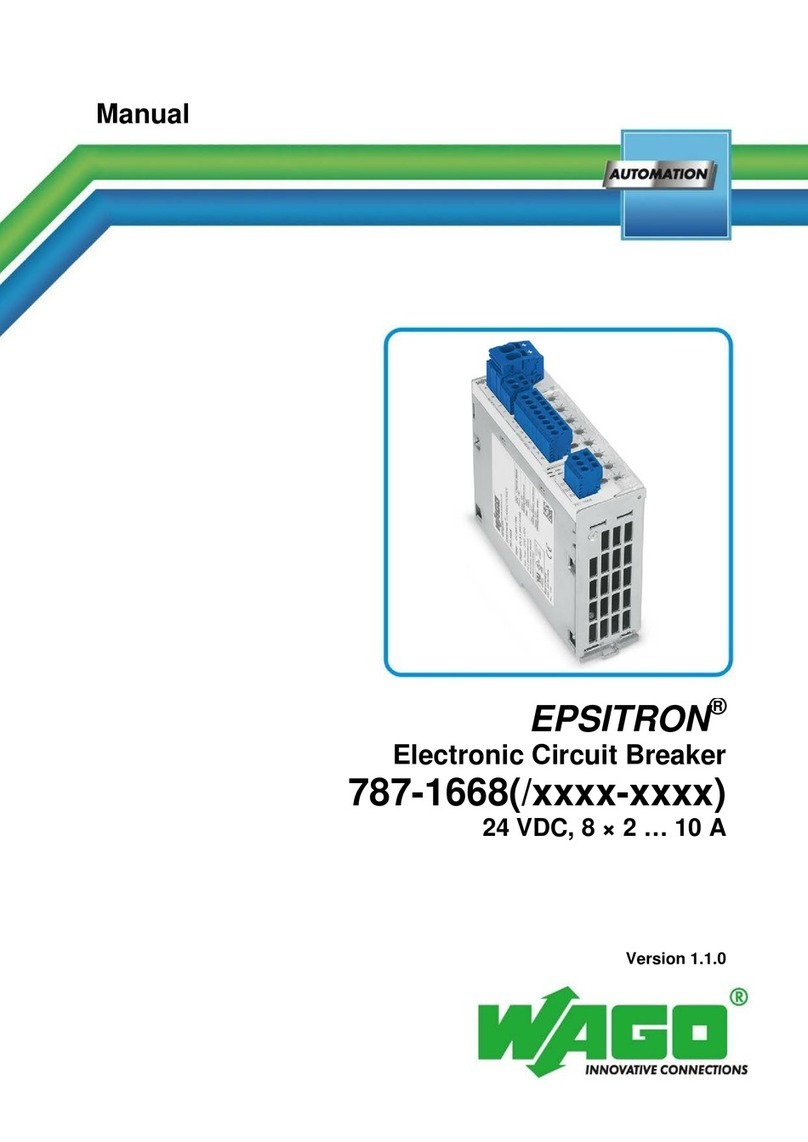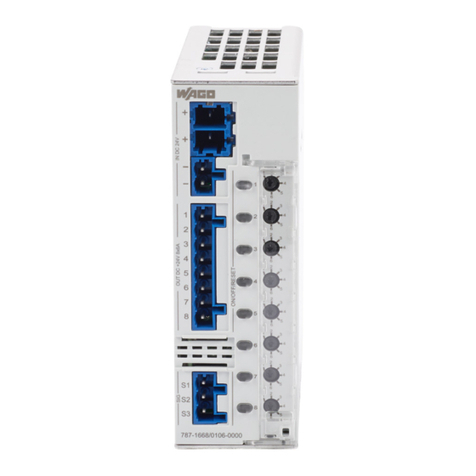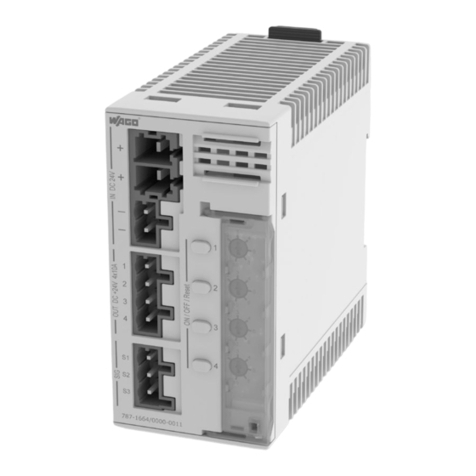
787-1664
787-1662
787-1664/0106-0000
787-1662/0106-0000
Eingangsdaten Input data Entrée
Output: 2 - 10 A / channel Output: 1 - 6 A / channel
Eingangsnennspannung Nominal input voltage
Tension nominale d‘entr ée
DC 24 V
Eingangsspannungsbereich Input voltage range
Plage de tension d‘entr ée
18 - 30 Vdc
Maximale Restwelligkeit/Rippel der spei-
senden Eingangsspannung
Maximal residual ripple of supplied input
voltage
Ondulation résiduelle maximale/ondulation
de la tension d‘entrée d‘alimentation
3%
Erforderliche Eingangsspannung zum
Einschalten der Ausgänge
Required input volt age for turning on of
outputs
Tension d‘entrée requise pour l‘acti vation
des sorties
20 V
Max. Dauerstrom des Moduls Max. total input curr ent Courant permanent max. du module
4 channel: 40 A
2 channel: 20 A
4 channel: 24 A
2 channel: 12 A
Max. Dauerstrom pro Klemmenpol Max. inpu t curr en t for each pole of terminal Courant permanent max . par pôle de borne 40 A
Überspannungsschutz
Suppressordiode
Over voltage protection
Suppressor diode
Protection contr e les surtensions
Diode transil
33 V
Ruhestrom im Leerlauf @ 24 V St and- by current @ 24 V Courant de repos à vide @ 24V 35 mA
Verlustleist ung im Leerlauf @ 24 V Power losses in st and- by mode @ 24 V Perte s en puissance à vide @ 24V 0,84 W
Anschlüsse Eingang Terminals input Raccordement entrée WAGO Series 831, max 6 mm² (2 x „+“)
WAGO Series 721, max 2,5 mm² (2 x „- “)
Ausgangsdaten Output data Sortie
Ausgangsnennspannung Nominal ou tput volt age Tension nominale de sortie DC 24 V
Ausgangsnennströme
einstellbar
Nominal output current
adjustable
Courants nominaux réglable des sorties 4 channel: 4 x (2, 3, 4, 6, 8, 10 A)
2 channel: 2 x (2, 3, 4, 6, 8, 10 A)
4 channel: 4 x (1, 2, 3, 4, 5, 6 A)
2 channel: 2 x (1, 2, 3, 4 , 5, 6 A)
Maximaler Spannungsabfall zwischen Ein-
und Ausgang
Maximum voltage drop between input and
output
Chute de tension ma ximale entre entr ée
et sortie
4 channel: 200 mV @ 4 x 10 A
2 channel: 200 mV @ 2 x 10 A
4 channel: 120 mV @ 4 x 6 A
2 channel: 120 mV @ 2 x 6 A
Modulinitialisierungszeit Initialization time Temps d‘initialisation de module 250 ms
Zuschaltverzögerung der Kanäle
lastabhängig
Turn-on delay of outputs
load dependent
Retard d‘ac tivat ion des canaux
selon la charge
min. 50 ms / ma x. 5 s
Wartezeit nach Abschaltung eines Aus-
gangs (Thermische Entspannung)
Kur zschluss (A ) ... Überlast (B)
Waiting periode after switch- o f f of an
output (thermal relaxation)
short circ uit (A) ... overload (B)
Temps d‘attente après mise hors service
d‘une sortie (dét ent e ther mique)
court-cir cuit (A) ... surcharge (B )
500 ms (A) … 20 s (B)
Maximale Verlustleistung Maximum power losses Perte s en puissance ma ximales 4 channel: 10 W @ 4 x 10 A
2 channel: 5,5 W @ 2 x 10 A
4 channel: 4,2 W @ 4 x 6 A
2 channel: 2,5 W @ 2 x 6 A
Wirkungsgrad Efficiency Rendement 99%
Maximale Last kapazität pro Ausgang Maximum turn-on capaci t y for each output Charge capacitive maximale par sortie > 50 … 500 mF
Integrierte Ausgangssicherungen pro
Ausgang
Internal ou tput fuse for each output Fusibles de sortie in terne par sortie 15 A
Rückspeisefestigkeit Resist ance to reverse feed ma x. Tension de retour max. 35 V
Parallelschaltung von Ausgängen Parallel use of output s Mon tage en parallèle de sorties -
Serienschaltung von Ausgängen Serial use of ou tputs Mon tage en série de sor ties -
Anschlüsse Ausgänge Terminals outputs Raccordement sorties 4 channel: Wago Series 721, max 2,5 mm² (4 x „+“ )
2 channel: Wago Series 721, max 2,5 mm² (2 x „+“)
Signalisierung Signaling Signalisation
Statusanzeige (pro Ausgang)
LED (r ot, grün, orange)
Status display (for each output)
LED (r ed, green, orange)
Indication du statut (par sortie)
LED (r ouge, verte, orange )
√
Signaleingang S1
(Ein/Aus/Reset)
Signal input S1
(On/Off/Reset)
Entr ée de commande S1
(Marche/Arrêt/Réinitialisation)
DC 24 V
Level high = min. 15 V, max. 30 V
Level low = min. 0 V, ma x. 5 V
Jitter: ± 5 % or ± 5 ms
Signalausgang S2
(Zustand der Ausgänge, kurzschlussfest)
Signal output S2
(status output channels, shor t circui t
proof)
Sortie de signalisation S2
(interrogation de l‘état des sorties, résis-
tant au cour t-cir cuit)
DC 24 V, max. 25 mA
Signalausgang S3
(Sammelmeldeausgang, kurzschlussfest)
Signal output S3
(summation message, short circuit proof)
Sortie de signalisation S3
(sor tie de message collec t if, résist an t au
court-circuit)
DC 24 V, max. 25 mA
S3 = 24 V: Status OK
S3 = 0 V: minimum one channel is t ripped
Anschlüsse Signalisierung Terminals signaling Raccordement signalisation WAGO Series 721, max 2,5 mm² (S1, S2, S3)
Umwelt Environment
Environnement
Lagertemperatur Storage temperature Température de stockage -25 °C ... +85 °C
Umgebungstemperatur Operational temperature Température ambiante -25 °C ... +70 °C
Konvektionskühlung Convection cooling Refroidissement par convection √
Luftfeuchtigkeit, keine Betauung Humidity, no condensation Humidi té de l‘air , absence de condensation 5 … 96 %
Einsatz in Bereichen mit
Verschmutzungsgrad 2
For installation in Pollution
Degree 2 environment
Pour installation dans un
environnement de pollution 2
√
Zum Anschluss Kupferkabel mit min. 60 °C
oder 60/75 °C verwenden
Use Copper Conductors only, rated 60 °C
or 60/75 °C
Utiliser uniquement des câbles de conne -
xion en cuivre supportant des plages de
températur es 60 °C ou 60/ 75 °C
√
Derating Derating Derating Max. out put current per channel:
10 A
total current (all channels
togehther):
max. 40 A @ 40 °C
max. 35 A @ 50 °C
max. 25 A @ 60 °C
max. 20 A @ 70 °C
no Derating
Erforderlicher Mindestabstand (seitlich) Required minimum spacing (left/right) Distance minimale requise (latérale) -
Erforderlicher Mindestabstand (oben/
unten)
Required minimum spacing (over/under) Distance minimale re quise (en haut /en bas) 40 mm
Allgemeine Daten G eneral data Données générales
Schutzar t nach IEC 60529 Degree of pr otection acc . to IEC 60529 Type de protection selon EN 60529 IP 20
Schutzklasse nach EN 61140 Protection class ac c. to EN 61140 Classe de protection selon EN 61140 III
Normen Safety standards Normes
Sicherheit Safety Sécurité EN 60950-1, EN 50178, EN /IEC 60204-1
EMV EMC CEM EN 61000-6-2, EN 61000-6-3
Schutzkleinspannung (SELV/PELV) Sa fet y extra- low volt age (SELV/PELV ) Trè s basse tension de sécuri té (TBT S/
TBTP)
IEC 60364- 4- 41 (DIN VDE 0100-410)
CE gemäß 2004/108/EG (EMV-Richtlinie) CE ac c. to 2004/108/ EG (EMC- Directive) Conf or me à la directi ve 200 4/108/EG
(CEM)
√
Prüfzeichen
Markings Approbation
UL 2367 UL 2367 UL 2367 Special-purpose Solid-state overcurrent protectors
UL 508 UL 508 UL 508 List ed for the use as Industrial Cont rol Equipment;
U.S.A. (UL 508) and Canada
GL GL
GL
GL (Germanischer Lloyd) classified, Environmental cat egor y: C, EMC2
Mechanische Daten Measures and weights Caractéristiques mécaniques
Befestigung auf Normprofilschiene
DIN EN 60715-TH35-15/ 7,5
Mounting on standard rail
DIN EN 60715-TH35-15/ 7,5
Montage sur rail
DIN EN 60715-TH35-15/ 7,5
√
Gewicht Weight Poids 0,2 kg
Maße (B x H x T)
Tiefe ab Oberkante TH35 inkl. Federleisten
Dimensions (W x H x D)
depth wit hout TH35, bu t incl. terminals
Dimensions (L x H x P) ;
prof ondeur sans TH35, mais avec bornes
45 x 90 x 115,5 mm
Bestellnummern Order numbers Références produit
Bestellnummer Order number Référence produit 4 channel: 787-1664
2 channel: 787-1662
4 channel: 787-1664/0106-0000
2 channel: 787-1662/0106-0000
Technische Daten Technical data Données techniques


























